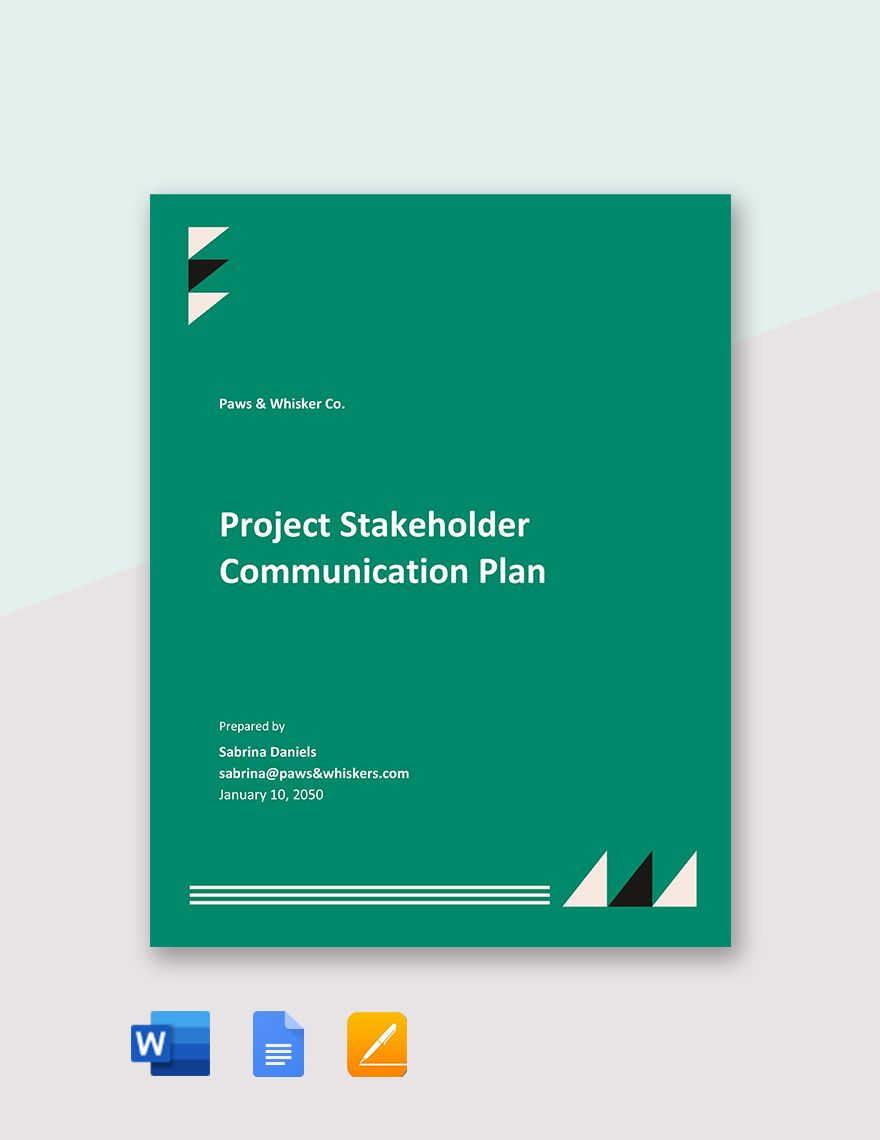Stakeholder Communication Plan
Embark on a journey to master the art of stakeholder engagement with our comprehensive guide on Stakeholder Communication Plan. This guide, enriched with practical Communication Examples, is tailored to address the nuances of effective stakeholder dialogue, from preventing Interpersonal Silence to overcoming Emotional Disconnection. Delve into strategies that counteract Non-Verbal Misunderstandings and Conflict Avoidance, ensuring your messages resonate effectively, fostering trust, and strengthening relationships in both professional and personal realms.
Download Stakeholder Communication Plan Bundle
Stakeholder Communication Plan
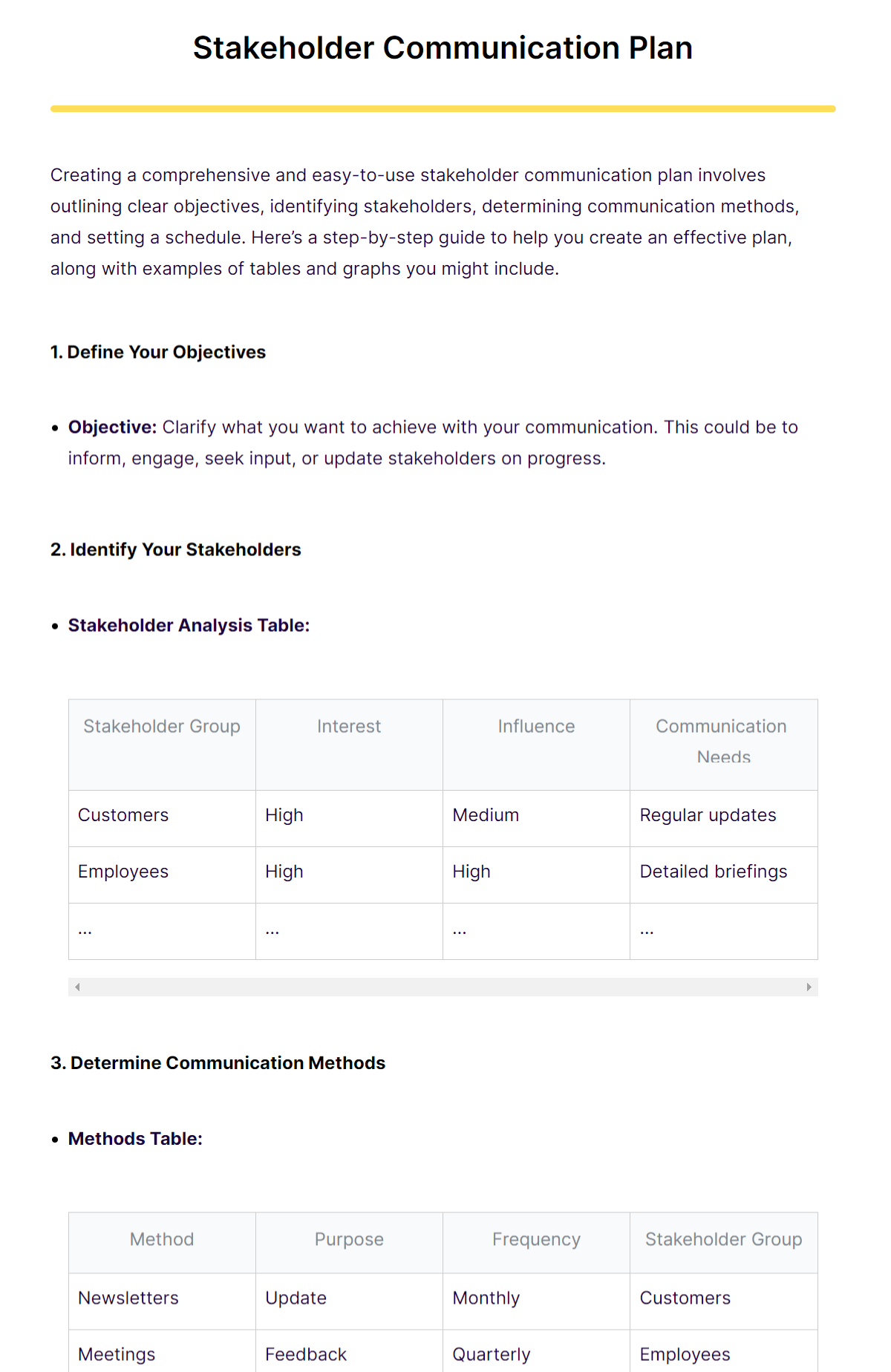
The step-by-step guide to creating a stakeholder communication plan, emphasizing clarity in objectives, understanding stakeholder needs, and employing effective communication methods. It details the importance of scheduling, responsibility allocation, and regular adjustments based on feedback, all crucial for project success and stakeholder engagement
Stakeholder Communication Plan in Project Management
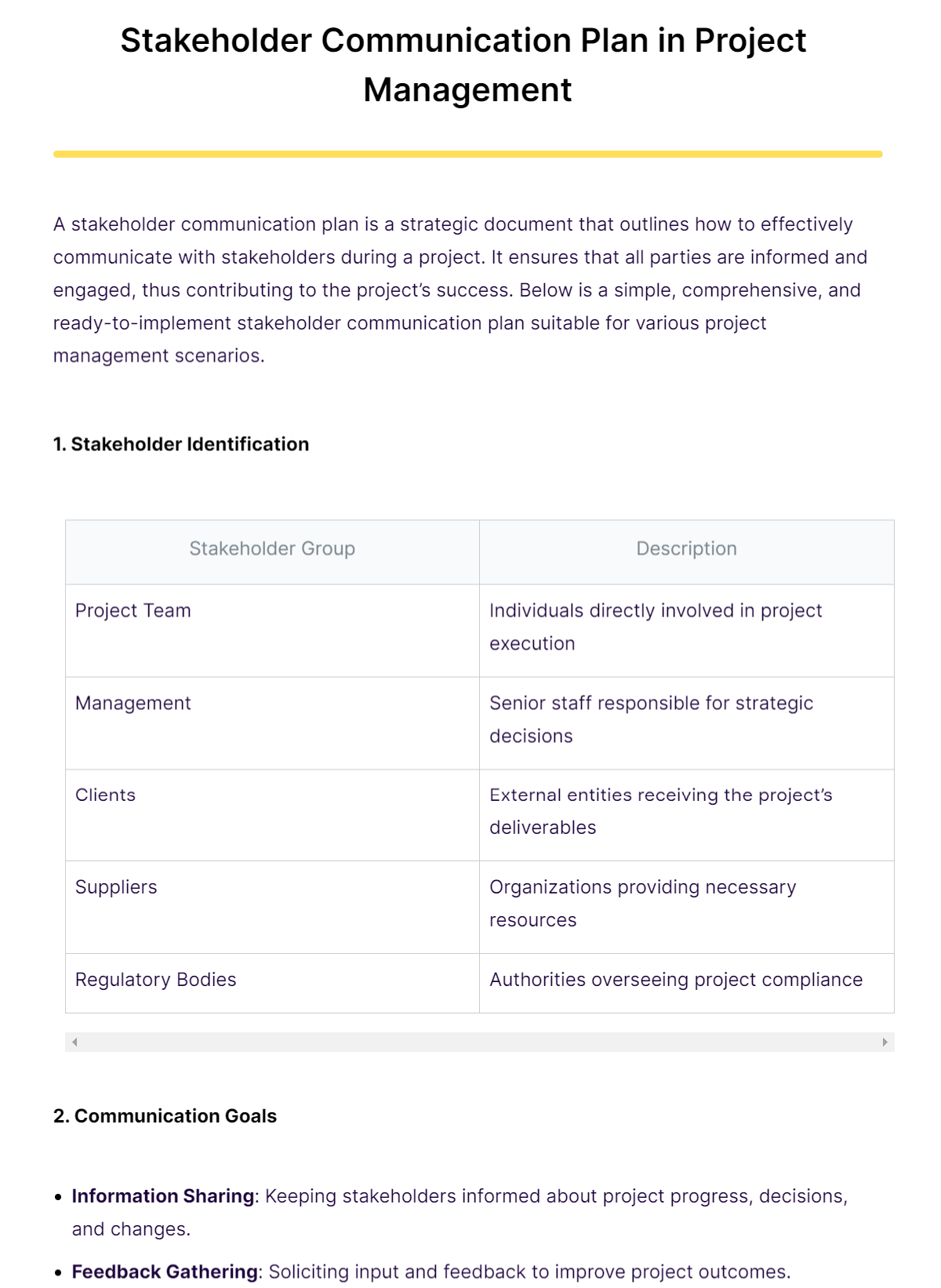
The comprehensive Stakeholder Communication Plan in Project Management, detailing strategies to ensure effective communication with stakeholders. It emphasizes the importance of identifying stakeholders, setting clear communication goals, choosing appropriate methods, and conveying key messages. The plan also highlights the necessity of monitoring, adjusting strategies based on feedback, managing risks, and maintaining a flexible timeline for implementation. This strategic document is designed to adapt to various project types, ensuring all parties are informed and engaged for project success
Stakeholder Mapping Communication Plan

The comprehensive guide for creating an effective Stakeholder Mapping Communication Plan. It covers the identification and analysis of stakeholders, setting communication skill objectives, developing tailored strategies, and implementing tools and tactics. The plan emphasizes regular monitoring and adaptation, underlining the importance of stakeholder engagement for improved project outcomes and relationships.
Stakeholder Management Communication Plan

The stakeholder management communication plan, essential for effective engagement and communication in any project or organization. It offers a simple yet comprehensive strategy, including stakeholder identification, communication objectives, methods, feedback mechanisms, and a responsibility matrix. Additionally, it emphasizes the importance of regular monitoring, adjustments, and a crisis communication plan to ensure timely and effective communication with all stakeholders for project success
Internal Stakeholder Communication Plan
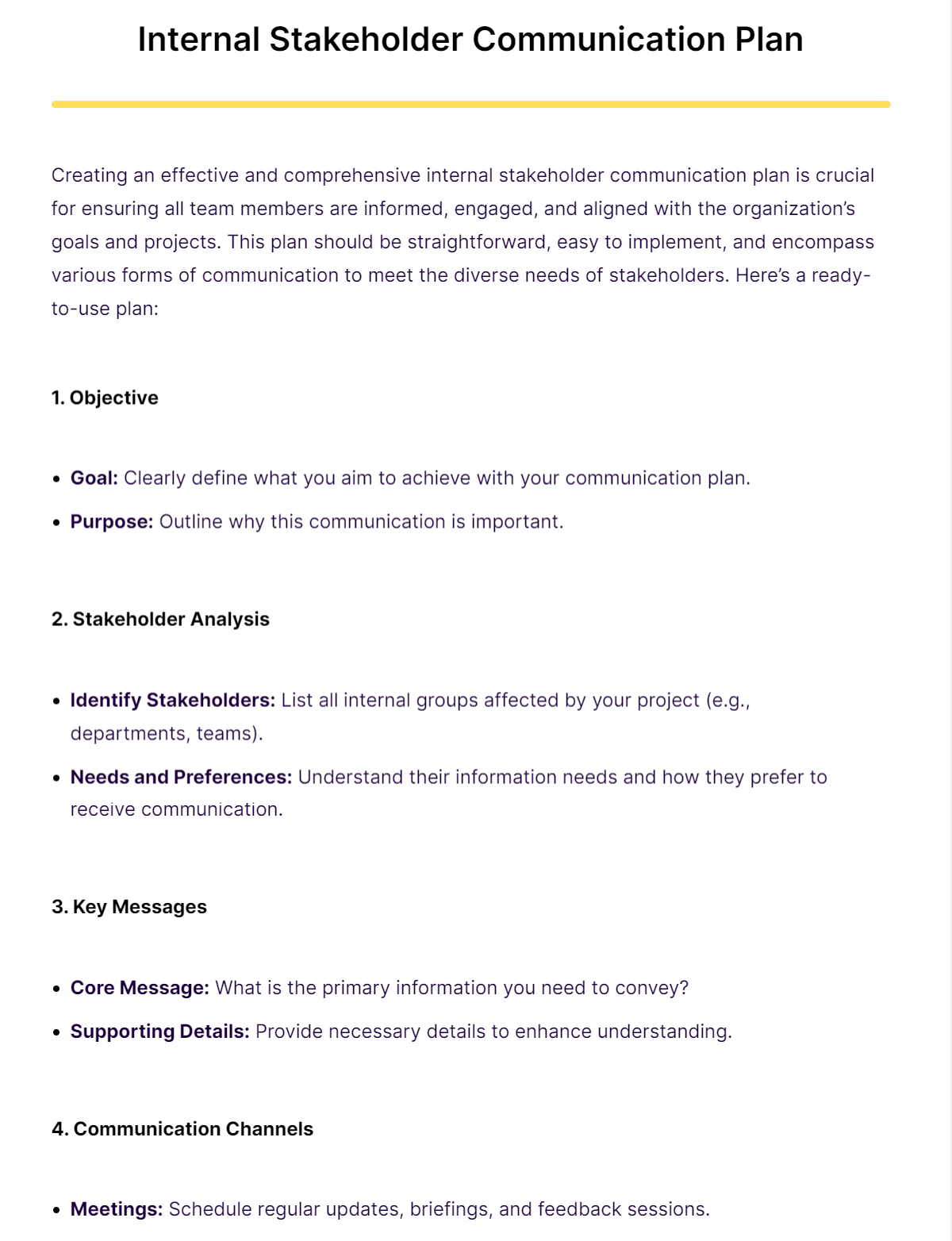
The “Internal Stakeholder Communication Plans” provides a comprehensive blueprint for creating an effective plan to keep team members informed, engaged, and aligned with organizational goals. It emphasizes the importance of clear objectives, stakeholder analysis, tailored messages, diverse communication channels, and regular updates. Additionally, it outlines roles, feedback mechanisms, and tools for monitoring and evaluation to ensure the plan’s effectiveness. This guide is essential for fostering a collaborative and well-informed workplace
Project Stakeholder Communication Plan
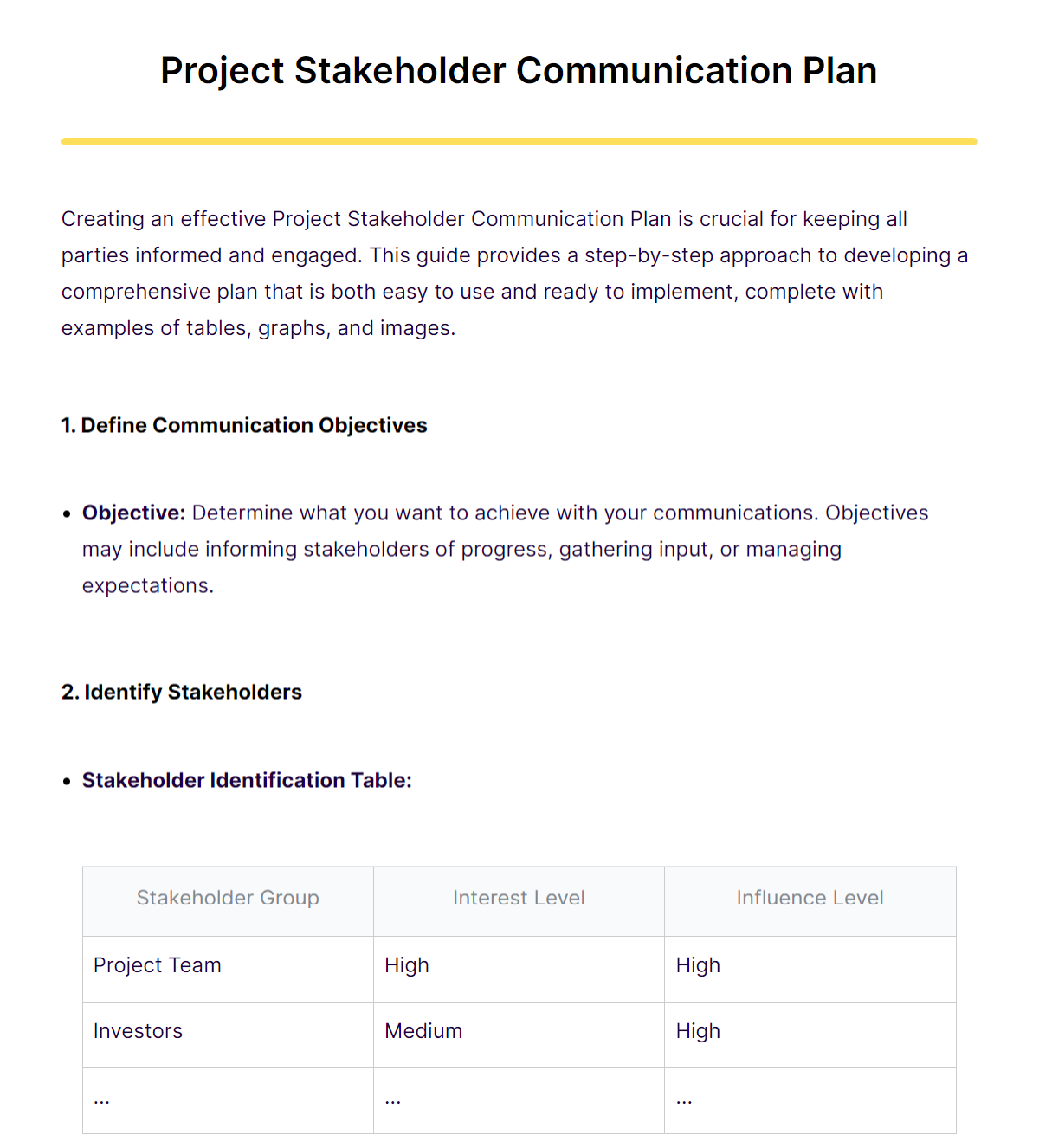
The effective Project Communication Stakeholder Plan. It emphasizes the importance of keeping all parties informed and engaged through a step-by-step process, including defining communication objectives, identifying stakeholders, assessing communication requirements, and developing and implementing the plan. With practical tools like tables for stakeholder identification and roles, as well as visual aids like stakeholder maps and Gantt charts, the guide is designed to be both easy to use and ready to implement for successful stakeholder communication
School Stakeholder Communication Plan Template
Project Stakeholder Communication Plan in Word
Stakeholder Communication Strategy Plan
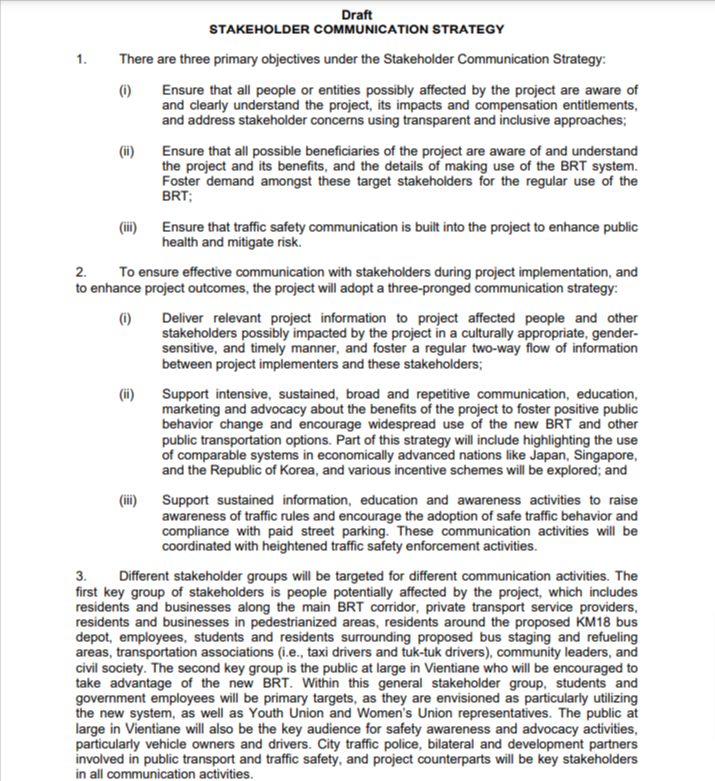
adb.org
DownloadStakeholder Engagement and Communication Plan
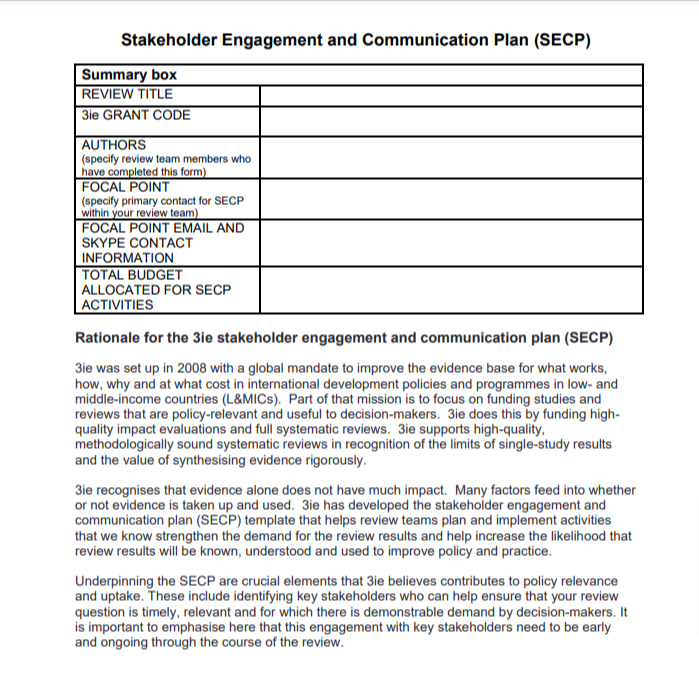
3ieimpact.org
DownloadElements of a Stakeholder Communication Plan
A Stakeholder Communication Plan is essential in orchestrating effective dialogue and managing relationships. It addresses Interpersonal Silence, mitigates Emotional Disconnection, and reduces Non-Verbal Misunderstandings. This plan is key to preventing Conflict Avoidance and Trust Erosion, ensuring that every message promotes understanding, collaboration, and Intimacy Challenges resolution.
- Stakeholder Identification: Identify all key stakeholders, ensuring no one crucial is overlooked.
Knowing who needs information is the first step in effective communication. - Communication Objectives: Define what you aim to achieve with each stakeholder interaction.
Clear objectives guide your strategy and ensure purpose-driven communication. - Message Framing: Craft messages that resonate with each stakeholder’s interests and concerns.
Tailored messages foster better understanding and engagement. - Channels of Communication: Determine the most effective channels for reaching each stakeholder group.
The right channels ensure your message is delivered and received as intended. - Frequency and Timing: Establish how often and when you’ll communicate with stakeholders.
Regular, timely updates keep stakeholders informed and engaged. - Responsibility Allocation: Assign team members specific communication roles and responsibilities.
Clear responsibilities ensure no stakeholder is neglected. - Feedback Mechanisms:
Implement methods for stakeholders to provide feedback on communications.
Feedback helps refine your approach and address concerns promptly. - Monitoring and Evaluation: Regularly assess the effectiveness of your communications.
Understanding what works and what doesn’t allows for continuous improvement. - Crisis Communication: Prepare for potential crises with a clear communication contingency plan.
Being prepared ensures you can manage and mitigate issues quickly. - Documentation and Record-Keeping: Keep records of all stakeholder communications for reference and accountability.
Documentation helps track progress and provides insights for future planning.
What is a Stakeholder Engagement Strategy and Communications Plan?
Understanding the facets of a Stakeholder Engagement Strategy and Communications Plan is crucial for any project or organization aiming to effectively engage with its stakeholders. This comprehensive guide will delve into the definition, importance, and key components of these strategies, ensuring content is optimized for “Stakeholder Communication Plan.”
Understanding Stakeholder Engagement Strategy
A Stakeholder Engagement Strategy is a systematic approach designed to identify, analyze, and engage with individuals or groups who have an interest or influence over your project or business. The primary goal is to build and maintain positive relationships with stakeholders through continuous and effective communication.
Key Elements of a Stakeholder Engagement Strategy:
- Identifying Stakeholders: Recognizing all the parties affected by or interested in your project.
- Understanding Stakeholder Needs: Analyzing and understanding the needs, expectations, and concerns of different stakeholders.
- Engagement Planning: Developing a plan to interact with stakeholders in a way that considers their influence and interest.
What is a Communications Plan?
A Communications Plan is a document that outlines how you will communicate with your stakeholders. It details what you will convey, to whom, how often, and through which channels. The plan ensures that everyone receives the right information at the right time and in the right way.
Key Elements of a Communications Plan:
- Communication Objectives: The goals you wish to achieve through your communication.
- Target Audience: The specific stakeholders you need to communicate with.
- Messages: Key information or updates you need to share with each stakeholder group.
- Channels: The mediums through which you will deliver your messages, such as emails, meetings, or social media.
- Frequency: How often you will communicate with each stakeholder group.
- Responsibilities: Team members responsible for each aspect of the communication.
Integrating Engagement Strategy with Communications Plan
Integrating your Stakeholder Engagement Strategy with your Communications Plan is critical for ensuring that your interactions with stakeholders are consistent, effective, and aligned with your project goals.
Benefits of Integration:
- Consistency: Ensures all stakeholders receive consistent messages aligned with project objectives.
- Efficiency: Streamlines communication efforts and avoids duplication.
- Feedback and Adaptation: Allows for two-way communication where stakeholders can provide feedback, and you can adapt your strategy accordingly.
Implementing the Strategy and Plan
- Develop a Schedule: Determine when and how often you will engage with each stakeholder group.
- Assign Roles: Clearly define who is responsible for each communication task.
- Monitor and Adjust: Continuously monitor the effectiveness of your communications and adjust your strategy and plan as needed.
How To Create an Effective Stakeholder Communication Plan?
Creating an effective Stakeholder Communication Plan is a strategic endeavor crucial for maintaining robust relationships and ensuring successful outcomes. This plan is a vital tool for navigating the complexities of stakeholder interactions, addressing Interpersonal Silence, mitigating Emotional Disconnection, and overcoming Non-Verbal Misunderstandings.
1. Identify Your Stakeholders: Start by identifying who your stakeholders are. This includes anyone affected by or interested in your project or organization – from employees and customers to partners and the public. Understanding their interests, influence, and expectations is crucial for addressing potential Conflict Avoidance and Trust Erosion.
2. Assess Stakeholder Needs and Expectations: Evaluate what each stakeholder group needs and expects from you. Some may require detailed technical updates, while others might be more interested in the broader impact of your work. Tailoring your communication to their needs helps prevent Miscommunication in Couples or teams and Relationship Breakdown.
3. Define Your Communication Objectives: Establish what you want to achieve with your communication. Communication Objectives may include informing stakeholders of progress, gathering input, managing crises, or changing perceptions. Clear objectives guide your strategy and help tackle issues like Intimacy Challenges and Expressive Barriers Example.
4. Develop Key Messages: Craft key messages that are clear, concise, and relevant to each stakeholder group. These messages should reflect your objectives and be designed to resonate with the audience, reducing the chance of Partner Detachment and enhancing understanding.
5. Choose the Right Communication Channels: Select the most appropriate channels to reach your stakeholders. This might include meetings, reports, social media, or direct emails. The right channels ensure your message is delivered effectively, addressing Bad Communication and Poor Communication Skills.
6. Plan the Communication Frequency: Decide how often you’ll communicate with each stakeholder group. Regular updates might be necessary for closely involved stakeholders, while others may only need occasional briefings. Consistency is key to maintaining relationships and managing expectations.
7. Prepare for Feedback: Establish mechanisms for receiving and responding to stakeholder feedback. This might include surveys, question-and-answer sessions, or suggestion boxes. Feedback helps you adapt your approach and address any issues, ensuring your communication remains effective.
8. Monitor and Adjust: Continuously monitor how your communication is received and be prepared to make adjustments. This includes being responsive to changing stakeholder needs, project developments, or external factors that might impact your communication strategy.
9. Train Your Team: Ensure that everyone involved in communication is trained and understands their role. This includes how to use the chosen channels, the frequency of communication, and the importance of maintaining a consistent and empathetic tone.
10. Review and Update Regularly: Your Stakeholder Communication Plan should be a living document. Regularly review its effectiveness, incorporate lessons learned, and make adjustments as needed. This ensures your plan stays relevant and continues to meet the needs of all stakeholders.
Why are Stakeholder Communication Plans Important?
Stakeholder Communication Plans are pivotal in establishing and maintaining successful relationships within any organization or project. Optimized for Stakeholder Communication Plan strategies, this guide explains why such plans are not just beneficial but essential for achieving objectives, preventing Conflict Avoidance, and fostering Trust Erosion repair.
1. Ensures Clarity and Consistency: Effective communication plans provide a clear and consistent message to all stakeholders. This clarity is crucial in preventing Miscommunication in Couples or teams, reducing Non-Verbal Misunderstandings, and ensuring everyone has a unified understanding of the project goals, status, and expectations.
2. Builds and Maintains Trust: Trust is the foundation of any strong relationship. By regularly communicating with stakeholders and keeping them informed, you mitigate Trust Erosion and demonstrate transparency and reliability, which are essential for long-term partnerships and Marriage or business success.
3. Enhances Engagement and Buy-In: When stakeholders are kept in the loop and feel their voices are heard, their engagement and commitment to the project or relationship increase. This involvement is crucial for navigating Intimacy Challenges and ensuring collaborative success.
4. Facilitates Better Decision Making: Informed stakeholders can provide valuable feedback and insights, leading to more informed and effective decision-making. This collaborative approach is essential for addressing Expressive Barriers and fostering an environment where innovative solutions thrive.
5. Manages Expectations: A well-crafted communication plan helps manage expectations by setting clear guidelines on what stakeholders can expect regarding project updates, responses, and involvement. Managing expectations is key to avoiding Blame and Bad Communication.
6. Identifies and Resolves Issues Early: Regular communication allows for the early identification of potential issues or concerns. Addressing these promptly can prevent minor misunderstandings from escalating into significant problems, such as Relationship Breakdown or project failure.
7. Supports Change Management: Change can be disruptive. Stakeholder communication plans play a critical role in change management by providing a structured approach to informing and guiding stakeholders through transitions, minimizing resistance and Conflict Avoidance.
8. Enhances Reputation and Public Image: For public-facing projects, how you communicate with external stakeholders can significantly impact your public image and reputation. Effective communication fosters a positive image and can be critical in times of crisis Comunication or public scrutiny.
9. Aligns Stakeholders with Organizational Goals: Communication plans ensure that all stakeholders understand the broader organizational goals and how their involvement contributes to these objectives. This alignment is essential for cohesive action and avoiding Partner Detachment.
10. Prepares for the Future: A solid stakeholder communication plan not only addresses current needs but also prepares the organization for future challenges. It creates a framework that can be adapted and expanded, ensuring resilience and readiness for whatever lies ahead.
How to Create Stakeholder Management Communication Plan Smartsheet?
Creating a Stakeholder Management Communication Plan using Smartsheet involves a structured approach to ensure all stakeholders are effectively informed and engaged throughout the project’s life cycle. This guide will walk you through the steps to create a comprehensive plan optimized for SEO and NLP, focusing on the term “Stakeholder Communication Plan.”
Step 1: Understand Stakeholder Needs
Before jumping into Smartsheet, take the time to identify and understand your stakeholders. Consider their interests, influence, and how the project will impact them. This understanding will guide the communication frequency, method, and message.
Step 2: Set Up Your Smartsheet
Smartsheet is a powerful tool for project management and communication planning. To start:
- Create a New Sheet: Select a grid, card, or Gantt chart view based on your preference.
- Customize Columns: Add columns for stakeholder names, interests, influence levels, communication methods, frequency, and message content.
Step 3: Populate Stakeholder Information
Fill in the details for each stakeholder or stakeholder group. Include all relevant information that will influence how you communicate with them.
Step 4: Define Communication Methods and Frequency
Determine the best way to communicate with each stakeholder group. Options might include email updates, meetings, reports, or newsletters. Decide on how often you’ll communicate and stick to this schedule.
Step 5: Plan Your Messages
Plan the key messages for each communication. Ensure they are clear, concise, and tailored to the audience. Incorporate feedback mechanisms to gauge stakeholder satisfaction and adjust as needed.
Step 6: Assign Responsibilities
Delegate tasks to team members. Assign someone responsible for each communication piece and ensure they know what’s expected.
Step 7: Implement, Monitor, and Adjust
Begin executing your plan. Monitor the effectiveness of communications and make adjustments based on stakeholder feedback and project evolution.
Step 8: Review and Optimize
Regularly review the plan’s effectiveness. Look for ways to improve and ensure the plan remains aligned with project goals and stakeholder needs.
Smartsheet Example for Stakeholder Communication Plan
| Stakeholder Group | Interest | Influence | Preferred Communication Method | Frequency | Next Communication Date | Message Content | Responsible |
|---|---|---|---|---|---|---|---|
| Project Team | High | High | Meetings & Email Updates | Weekly | 01/01/2024 | Project updates | John Doe |
| Customers | Medium | Low | Monthly Newsletter | Monthly | 01/02/2024 | New features | Jane Smith |
| … | … | … | … | … | … | … | … |
In conclusion, a comprehensive Stakeholder Communication Plan is essential for fostering positive, productive relationships with various groups. By integrating strategies from expert resources such as INSEAD’s insights on successful stakeholder communication, organizations can enhance cooperation and mitigate conflict. Additionally, considering the broader implications and best practices from governmental perspectives, like those detailed in Stakeholders and Develop Communications Plan can provide a robust framework for effective engagement, ensuring that all communications are timely, relevant, and impactful.





